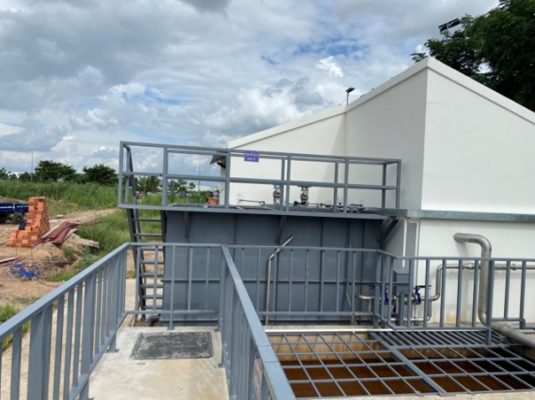On July 10, 2023, the University of Nguyen Tat Thanh completed the handover of the 150m3/day-night capacity Wastewater Treatment Plant under the Nguyen Tat Thanh University High-Tech Development Center project.
Attending the handover session, the University representatives included Mr. Hoang Van Huong – Head of the Construction Department; Mr. Pham Ngoc Bich – Deputy Head of the Construction Department; Mr. Vu Dinh Thinh – Deputy Head of the Construction Department; Mr. Nguyen Hai Hung – Specialist. The contractor’s representatives included Mr. Nguyen Ngoc Doanh – Chief Commander; and Mr. Le Huu Hai – Technical Officer.
During the meeting, all parties agreed to hand over the Wastewater Treatment Plant with a capacity of 150m3/day-night to Nguyen Tat Thanh University for operation and use. It is expected that the Wastewater Treatment Plant, when put into operation, will fully meet the requirements for wastewater treatment of the Nguyen Tat Thanh University High-Tech Development Center project. The technological process applied to the Wastewater Treatment Plant with a capacity of 150m3/day-night includes the following steps:
- Collection tank:
Pumping domestic wastewater, laboratory wastewater, and other sources of wastewater. The collection tank is equipped with screens to remove large debris, ensuring smooth flow and preventing pipe damage.
- Conditioning tank:
Regulating water flow and stabilizing the concentration of pollutants in the wastewater. In the conditioning tank area, an air diffuser system will mix the wastewater throughout the tank area. This prevents sedimentation and odor formation, as well as reduces the suspended organic matter in the wastewater.
- Nitrogen Removal Tank (Anoxic Tank):
The Nitrogen Removal Tank, also known as the Anoxic Biological Tank, uses facultative microorganisms (with or without oxygen) to decompose organic compounds containing Nitrogen and Phosphorus in the wastewater.
- Aerobic tank:
Treating pollutants in the wastewater through the activity of aerobic microorganisms. The organic pollutants in the wastewater are used as nutrients by aerobic microorganisms for growth and development. The tank is equipped with a continuous air diffuser system to supply oxygen for the beneficial microorganisms to function.
- Sedimentation tank:
Under the influence of gravity and flow direction plates, the wastewater in the distribution pipes will settle the sludge at the bottom. The collected water will continue to flow to the next tank for further treatment. The collected sludge will be appropriately treated according to the domestic wastewater treatment process. Additionally, the tank retains a certain amount of activated sludge. Some of the settled sludge will be transferred to a storage and digestion tank, while the rest will be recirculated to the anoxic tank to maintain the sludge concentration.
- Disinfection tank:
In the tank, a certain amount of chemical (chlorine solution) is added to eliminate bacteria and viruses that cause diseases. Moreover, the chlorine chemical also helps prevent bacterial recontamination in the wastewater. The treated water discharged from the tank meets the QCVN 28:2010/BTNMT standards.
Principle diagram
Technological process of a 150m3/day-and-night wastewater treatment plant





Sources: Construction Department – Nguyen Tat Thanh University
 1900 2039 – Ext: 408
1900 2039 – Ext: 408 thuvienntt@ntt.edu.vn
thuvienntt@ntt.edu.vn






